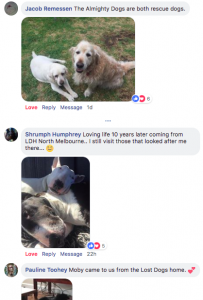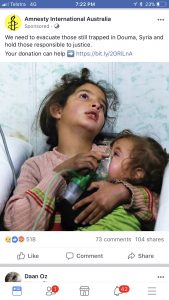It seems that every charity with a regular giving program wants to use Facebook advertising to increase their supporter base and generate new RG leads. We’ve all seen the success stories at conferences – but the flops don’t get the same exposure. So when F&P asked me to share our insights I rounded up the most regular offenders to compile the Seven Sins of Facebook Lead Gen.
- Not maintaining the conversation
With the right ad (and sometimes a very wrong ad) you’ll get a lot of comments and reactions to your ads from the community. If supporters and prospective donors take the time to comment on your post, it’s really important to respond and interact with these supporters – to thank them, to console them, to correct them or even just give them a thumbs up.
Too many organisations don’t put the required resources into moderating the comments. Before the campaign kicks off you should know who is going to be responding (another battle between Fundraising and Marketing or you could have an agency do the work) and have a brainstorm to pre-empt some tricky questions that may come up and have responses ready to go.


- Under-valuing the power of the image

Facebook is a very visual medium. In the 10 years I’ve been running Facebook campaigns, I know that the image is the most impactful element. If a campaign isn’t performing well, changing the image is the first lever we pull. To do that we need a collection of 5-10 good images that show the person and demonstrate the need and the solution. Often, we’re lucky if we get 2 good images that we know will work and the organization will agree to.
We all know that charities are rich with great case studies but often the images don’t have the same quality as the story. Many organisations have policies (rightly designed to protect their clients) that prevent the use of real photos. Others forbid the use of stock images. Brand guidelines can restrict the use of pictures showing the need at its greatest (often perceived as a negative) and instead will only use positive imagery. All of these decisions have been made for good reasons. But, it often makes it difficult to create a compelling campaign. Especially one that will hit all your engagement, volume and cost per lead targets.

- Forgetting the cost of content
Setting up a Facebook campaign shouldn’t take long. For an in house team, maybe 3-5 days’ work to write the ads, set up the campaigns for your target audiences, get the tracking in place and prepare some responses for tricky questions and comments.
BUT, none of that can be done without the case study. You need to choose the right one with visual and written content is ready. This can then be adapted into image and video ads and lead capture landing pages.
This is often where I spend most of my time, trawling through case studies, searching for ones that can demonstrate clearly who the organisation helps and how – so that we can show that to the audience and get them to feel compassion and compel them to act. - Not automating the data process for a “Test”
Automation is something every organisation wants to reduce the manual workload for their staff. However, more often than not I hear Fundraising managers say, “we’ll see how the test goes and then we’ll look at automation”.
If you’re paying $50,000 to set up a Digital Lead Gen test with case study creation, Ad campaign and optimisation, creating a data capture landing page with onboarding journey, then surely you can spend $2-3,000 to automate the process and set yourselves up for business as usual?
Automating the data from your landing page into your email system may cost as little as $750 or as much as $1,400, depending on the platforms you’re using and how you choose to do it.
There are tools like Braintree that can automate the data from an in-Facebook lead campaign (where they don’t click to your landing page).
Setting up automation with your telemarketing agency is also going to mean that your leads can be called faster. Automation should be a mandatory requirement, not a phase 2. - Assuming more money equals more donors
I love it when an organization comes to us at Parachute Digital and has an aggressive target to build a database of engaged supporters in a short time (4-6-weeks). I love a challenge and a fast campaign – but many times in the last year I’ve had budget that I just couldn’t spend.
Here are some reasons why you may not be able to get as many leads as you want or spend the budget you have available:
– Your target audience is very niche and there aren’t enough of them available within Facebook
– Your campaign isn’t resonating with your audience (low relevancy/ low CTR) and Facebook isn’t showing your ad as much as you’d like
– Your campaign Cost per Lead conversion (i.e. $3) or Cost per Click (i.e. $1.00) or Cost per Thousand Impressions (I.e. $5.00) ‘bid cap’ is set too low
– Your existing audience (email database, website visitors and Facebook fans) is too small a base from which to reach and build a big enough look-a-like audience from (you can upload/ link Facebook to your website visitors, Page Likers or donor base and can target your campaign to people who have a similar profile to your existing supporters aka “look-a-like”)
– You can spend your budget to drive traffic but if it’s not converting this makes no sense, so we end up pausing a campaign to optimize it to avoid wasting budget without results.
As an aside, $2,500 a week is about what I’ve seen is the maximum you can spend in a long-term Facebook lead generation campaign. It works better in the $1,000 a week range. - Underestimating the time
Setting up a Facebook lead gen campaign takes a lot more time and effort than simply putting some posts together. When using an agency that goes through all the due diligence steps, you can expect a campaign to be 5-10 days of effort, depending how well developed your case study is and if you already have a landing page developed.I find some organisations feel conflicted when they see the agency cost is so much more than the actual media budget you need to invest to get the leads. Often a small campaign may only spend $3,000 in advertising media budget but will cost your organisation 5 times that in agency fees to set it up.
Whether you do the campaign in house or get an agency to do it, it takes time and effort.
I’m not saying that Facebook advertising for appeals and one-off donations doesn’t have a positive halo effect – but I AM saying that there is no volume in it (a trickle at best) and it will not have a positive ROI. - Believing people donate directly through Facebook
A couple of years back I ran a few Facebook ad campaigns to support a Tax or Christmas appeals but quickly learned that they don’t work. As a consultant, I’ve been hired to review digital activity for the past 2 years and help them understand why their campaigns haven’t been a success. Several times I’ve seen organisations spend $20,000 each appeal, for 3 or 4 subsequent appeals, and generate between 4 and 10 donations per appeal. This is madness.In my long experience, the only time people click on a Facebook ad and donate is when there is an emergency or when it’s their friend asking (peer to peer). Of course, there are exceptions to the rule, but they are few and far between.
Facebook is an exciting channel for fundraising and at the moment it is the best digital channel many organisations have for generating leads that they don’t have to share with half a dozen other organisations. However, we can do better – this article aims to help you correct some of the mistakes you’ve likely been making. Comment and let us know of your experiences.

Great list – I’d agree with everything except point 7 which is completely incorrect in our experience – ‘Believing people donate directly through Facebook’
We see thousands of direct donations through facebook each year (both direct from ad clicks and also 1 or 7-day conversion windows). It’s a major direct income channel for appeals on top of the obvious engagement and lead gen.
People should test it as there are so many options – email lists, lookalike audiences, remarketing ads based on engagement (eg video viewers), website engagement (visitors to your donate page) etc…
Also setting a 7 day conversion window allows you to see what content people engaged with that then helped them decide to donate later… very useful!